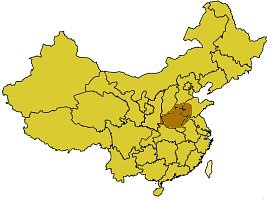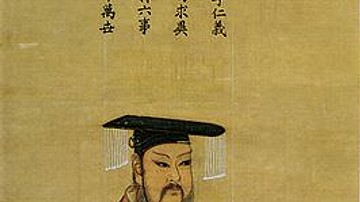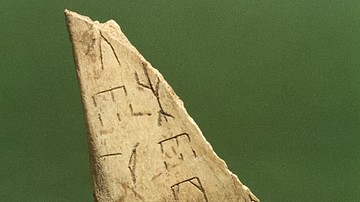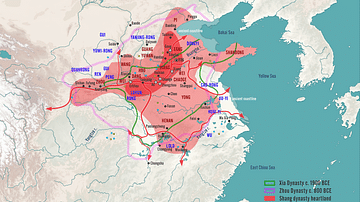
The Xia Dynasty (c. 2070-1600 BCE) was the first government to emerge in ancient China and the first to adopt the policy of dynastic succession. Consequently, the Xia was the first dynasty of China. Long regarded as a mythical construct of later Chinese historians, 20th-century excavations uncovered sites which corresponded to descriptions in earlier historians' accounts.
The Xia Dynasty was overthrown by the Shang Dynasty (c.1600-1046 BCE), a more historically certain governmental entity, which was in turn overthrown by the Zhou Dynasty (1046-256 BCE).
The argument claiming the Xia Dynasty is a mythological construct claims that the Zhou (and later dynasties) wanted to make clear that the previous ones lost their right to rule through immoral conduct and so created a proto-dynasty - the Xia - as a pre historic model for this. Many scholars today still maintain that the Xia Dynasty is a myth but seem to be at a loss to explain why the physical evidence uncovered argues against their claim. Those who believe the Xia Dynasty was a reality are at an equal disadvantage in that none of the sites uncovered so far positively identify themselves as belonging to the Xia Dynasty and could as easily be interpreted as early Shang Dynasty buildings.
The Rise of the Xia
According to historians like Sima Qian (145-86 BCE), there was once a great ruler named Huang-ti (also Huangdi, `emperor') better known as the Yellow Emperor who emerged from the tribal system pre-historic China to rule the region of Shandong between 2697-2597 BCE. The Yellow Emperor created Chinese culture and established a form of government which would last for centuries. He is credited with inventing musical instruments, developing the production of silk, instituting law and customs, and the development of medicine and agriculture. Upon his death, he was buried in Huangling County, Shaanxi Province in the mausoleum which is today a popular tourist attraction.
Huang-ti was succeeded by his grandson Zhuanxu, one of the famous Five Emperors, who founded the Xia tribe. After defeating their rivals, the Xia established the first dynasty in China under the leadership of the Emperor Yao. Yao ordered great palaces to be built and small villages of huts grew into urban centers. He is considered a great philosopher-king who ruled his people wisely and worked in their best interests following the precepts of Huang-ti.
The Flood
Yao had a serious problem during his reign in controlling the flooding of the Yellow River which disrupted agriculture as well as drowning or displacing his people. He appointed a man named Gun (revered as a demi-god in many accounts) to take care of this situation.
Gun tried for nine years to stop the flooding but every year the waters grew stronger and more lands were covered and people killed. Finally, Gun constructed a series of dykes which he hoped would hold back the water but the dykes collapsed, causing further destruction and death. Yao had relinquished rule by this time to his successor Yu Shun who was not pleased at Gun's failure to control the waters. According to some versions of the tale, Gun then killed himself while according to others he was imprisoned by Yu Shun and still others report he exiled himself to the mountains. After he was gone, Emperor Shun appointed Gun's son Yu to complete the work and stop the flooding.
Yu the Great
Yu learned from his father's mistakes: Gun had tried to do too much by himself, had underestimated his need for help, and had overestimated his own abilities. He had also acted without respect for the forces of nature and had worked against the water instead of working with it. Yu enlisted the aid of the surrounding tribes and had them construct canals which would work with the water to lead it out toward its own kind in the sea.
Yu's project lasted thirteen years and he was so dedicated to his task that he never visited his home once, even though he passed by it three times in his work. Yu's wife and young son would call out to him as he passed and his colleagues would encourage him to go home for a rest but Yu would not abandon his task until it was completed. He claimed there were many who were homeless, who had lost their own wives and children to the flooding, and he did not feel he should rest until the problem was solved. His single-mindedness and dedication to his work inspired those around him who looked up to him as a role model and worked harder until the waters of the river were contained and there were no more floods.
Once the water problem had been solved, Shun was very proud of Yu and placed him in command of his army. Yu led his men against the Sanmiao, a tribe hostile to the Xia who continuously raided their borders. He defeated the Sanmiao and drove them from the land and, as a reward for his victories, Shun declared him heir to the throne.
Yu's rule is considered the beginning of the Xia Dynasty and he is known as Yu the Great not only for his victories over the flood and the Sanmiao but for the establishment of a stable central government and the organization of the country into nine provinces to make governing such an enormous area more manageable.
Death of Yu & Decline of Xia
Yu ruled for 45 years and, on his deathbed, named his son Qi as his successor. Qi had been a young boy during the time of the great flood and many people loved him for the story of how his father refused to return home until the flooding had been stopped and how young Qi bore his father's absence so well. Yu had intended to name his minister as successor, not wishing his son to have the burden of rule, but so many people favored Qi that Yu had no choice. In naming Qi his successor, Yu initiated the policy of dynastic succession.
Qi's son, Tai Kang, was a poor ruler but many of his successors were highly skilled and numerous inventions and innovations are attributed to the later Xia, such as the development of armor in warfare and rules of chivalry in battle. The fourth ruler after Qi was the great hero Shao Kang who revitalized the country and is well known through the many legends which tell his tales. The Xia Dynasty began to decline under the rule of Kong Jia (c. 1789 -1758 BCE) who cared more for strong drink than the responsibilities of rule. He was succeeded by Gao who was succeeded by Fa, neither of whom did a great deal to improve the lives of anyone but themselves. The last emperor was Jie (1728-1675 BCE) who was known as a tyrant and who lost the mandate of heaven to rule. He was overthrown by Tang who established the Shang Dynasty.
Mythology vs. History
Much of the above was considered mythology from the 1920's CE until the mid-1960's CE when archaeological evidence began to emerge to corroborate the tales of the historians. Even now, the scholarly consensus is that the history of the Xia Dynasty is largely mythological even if such a dynasty did actually exist. The scepticism grew because there were no early accounts of the Xia Dynasty and because no physical evidence argued for its existence. It was thought that historians, especially the famous Sima Qian, created the Xia Dynasty as a model precedent to explain and justify dynastic change in China. The scholar Justin Wintle explains this:
Sima had a specific political purpose [in giving credence to mythological figures and events]. In his view, as in the view of others, rulers were entitled to govern by the "Mandate of Heaven"...If they misgoverned, then that license was forfeit. The Yellow Emperor and his successors, including Yu, not only invented all the essentials of civilizations, but provided a model government. As a result of human corruption, however, this divinely instituted order soon collapsed, and thus began the familiar "dynastic cycle". A new regime comes to power, but sooner or later loses the divine right to govern, at which point it is replaced by another that does enjoy the Mandate. And this transferability of the Mandate, Sima Suggests, is the underlying principle of history (3).
The mythological interpretation of the Xia Dynasty was challenged in the 1960's/1970's CE with the discovery of palaces and four-walled homes (as distinct from earlier round homes) matching the descriptions of the historians who wrote on the Xia Dynasty centuries after its decline. Further evidence of the Xia's existence has been discovered since but no written record on any of these structures positively identifies them as Xia constructs and so the debate continues on whether the first dynasty of China was a reality or simply a politically motivated fabrication of later writers.








